| Article ID | Journal | Published Year | Pages | File Type |
|---|---|---|---|---|
| 1769294 | Advances in Space Research | 2006 | 5 Pages |
Abstract
The dramatic changes seen in the X-ray spectral and timing properties of accreting black hole candidates (BHCs) provide important clues about the accretion and jet formation processes that occur in these systems. Dividing the different source behaviors into spectral states provides a framework for studying BHCs. To date, there have been three main classification schemes with Luminosity-based, Component-based, or Transition-based criteria. The canonical, Luminosity-based criteria and physical models that are based on this concept do not provide clear explanations for several phenomena, including hysteresis of spectral states and the presence of jets. I discuss the re-definitions of states, focusing on an application of the Component-based states to more than 400 RXTE observations of the recurrent BHC 4U 1630-47. We compare the X-ray properties for the recent 2002-2004 outburst to those of an earlier (1998) outburst, during which radio jets were observed. The results suggest a connection between hysteresis of states and major jet ejections, and it is possible that both of these are related to the evolution of the inner radius of the optically thick accretion disk.
Related Topics
Physical Sciences and Engineering
Earth and Planetary Sciences
Space and Planetary Science
Authors
John A. Tomsick,
